Search results for: 'SEWING MACHINES''
- Related search terms
- SEWING+MACHINES'
- sewing machin
- Sewing machine
- SEWING MAC
- SEWING+MACHINES'[0]
-
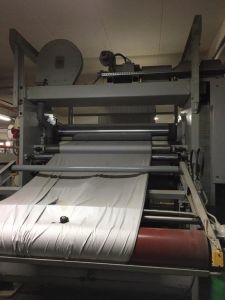 RAMISCH KLEINEWEFERS CALENDER, WORKING WIDTH 1800mm, YEAR 1991REFERENCE NUMBER: T-6919 RAMISCH KLEINEWEFERS CALENDER, WORKING WIDTH 1800mm, YEAR 1991 RAMISCH KLEINEWEFERS CALENDER YEAR 1991 WORKING WIDTH 1800mm 3 CYLINDERS 2 STEEL 1 RACOLAN UPPER AND LOWER CYLINDERS ARE ELECTRIC HEATED WITH METAL AND SEWING DETECTOR TEMP. 190 °C WORKING PRESS 50 BAR MACHINES ARE IN EXCELLENT RUNNING CONDITION QUANTITY: 1 Learn More
RAMISCH KLEINEWEFERS CALENDER, WORKING WIDTH 1800mm, YEAR 1991REFERENCE NUMBER: T-6919 RAMISCH KLEINEWEFERS CALENDER, WORKING WIDTH 1800mm, YEAR 1991 RAMISCH KLEINEWEFERS CALENDER YEAR 1991 WORKING WIDTH 1800mm 3 CYLINDERS 2 STEEL 1 RACOLAN UPPER AND LOWER CYLINDERS ARE ELECTRIC HEATED WITH METAL AND SEWING DETECTOR TEMP. 190 °C WORKING PRESS 50 BAR MACHINES ARE IN EXCELLENT RUNNING CONDITION QUANTITY: 1 Learn More -
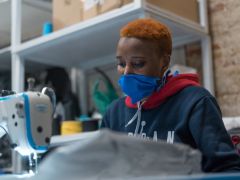 D-2388 What’s the Best Material for a Mask?
D-2388 What’s the Best Material for a Mask?Federal health officials have now recommended that we cover our faces with fabric during the coronavirus pandemic. But what material offers the most protection?
The Centers for Disease Control and Prevention has posted a no-sew mask pattern using a bandanna and a coffee filter as well as a video on making masks using rubber bands and folded fabrics found at home.
While a simple face covering can reduce the spread of coronavirus by blocking outgoing germs from coughs or sneezes of an infected person, experts say there is more variation in how much homemade masks might protect the wearer from incoming germs, depending on the fit and quality of the material used.
Scientists around the country have taken it upon themselves to identify everyday materials that do a better job of filtering microscopic particles. In recent tests, HEPA furnace filters scored well, as did vacuum cleaner bags, layers of 600-count pillowcases and fabric similar to flannel pajamas. Stacked coffee filters had medium scores. Scarves and bandanna material had the lowest scores, but still captured a small percentage of particles.
If you don’t have any of the materials that were tested, a simple light test can help you decide whether a fabric is a good candidate for a mask.
“Hold it up to a bright light,” said Dr. Scott Segal, chairman of anesthesiology at Wake Forest Baptist Health who recently studied homemade masks. “If light passes really easily through the fibers and you can almost see the fibers, it’s not a good fabric. If it’s a denser weave of thicker material and light doesn’t pass through it as much, that’s the material you want to use.”
Researchers say it’s important to remember that lab studies are conducted under perfect conditions with no leaks or gaps in the mask, but the test methods give us a way to compare materials. And while the degree of filtration for some homemade masks seems low, most of us — who are staying home and practicing social distancing in public — don’t need the high level of protection required for medical workers. More important, any face covering is better than none, especially if worn by a person who has the virus but doesn’t know it.
The biggest challenge of choosing a homemade mask material is to find a fabric that is dense enough to capture viral particles, but breathable enough that we can actually wear it. Some items being touted online promise high filtration scores, but the material would be unwearable.
Dressing Up for Work … at Home
Yang Wang, an assistant professor of environmental engineering at Missouri University of Science and Technology, worked with his graduate students to study various combinations of layered materials — including both air filters and fabric. “You need something that is efficient for removing particles, but you also need to breathe,” said Dr. Wang, who last fall won an international award for aerosol research.To test everyday materials, scientists are using methods similar to those used to test medical masks, which everybody agrees should be saved for medical workers who are exposed to high doses of virus from seeing infected patients. The best medical mask — called the N95 respirator — filters out at least 95 percent of particles as small as 0.3 microns. By comparison, a typical surgical mask — made using a rectangular piece of pleated fabric with elastic ear loops — has a filtration efficiency ranging from 60 to 80 percent.
Dr. Wang’s group tested two types of air filters. An allergy-reduction HVAC filter worked the best, capturing 89 percent of particles with one layer and 94 percent with two layers. A furnace filter captured 75 percent with two layers, but required six layers to achieve 95 percent. To find a filter similar to those tested, look for a minimum efficiency reporting value (MERV) rating of 12 or higher or a microparticle performance rating of 1900 or higher.
The problem with air filters is that they potentially could shed small fibers that would be risky to inhale. So if you want to use a filter, you need to sandwich the filter between two layers of cotton fabric. Dr. Wang said one of his grad students made his own mask by following the instructions in the C.D.C. video, but adding several layers of filter material inside a bandanna.
Dr. Wang’s group also found that when certain common fabrics were used, two layers offered far less protection than four layers. A 600 thread count pillow case captured just 22 percent of particles when doubled, but four layers captured nearly 60 percent. A thick woolen yarn scarf filtered 21 percent of particles in two layers, and 48.8 percent in four layers. A 100 percent cotton bandanna did the worst, capturing only 18.2 percent when doubled, and just 19.5 percent in four layers.
The group also tested Brew Rite and Natural Brew basket-style coffee filters, which, when stacked in three layers, showed 40 to 50 percent filtration efficiency — but they were less breathable than other options.
If you are lucky enough to know a quilter, ask them to make you a mask. Tests performed at the Wake Forest Institute for Regenerative Medicine in Winston-Salem, N.C., showed good results for homemade masks using quilting fabric. Dr. Segal, of Wake Forest Baptist Health, who led the study, noted that quilters tend to use high-quality, high-thread count cotton. The best homemade masks in his study were as good as surgical masks or slightly better, testing in the range of 70 to 79 percent filtration. Homemade masks that used flimsier fabric tested as low as 1 percent filtration, Dr. Segal said.
The best-performing designs were a mask constructed of two layers of high-quality, heavyweight “quilter’s cotton,” a two-layer mask made with thick batik fabric, and a double-layer mask with an inner layer of flannel and outer layer of cotton.
Bonnie Browning, executive show director for the American Quilter’s Society, said that quilters prefer tightly woven cottons and batik fabrics that stand up over time. Ms. Browning said most sewing machines can handle only two layers of fabric when making a pleated mask, but someone who wanted four layers of protection could wear two masks at a time.
Ms. Browning said she recently reached out to quilters on Facebook and heard from 71 people who have made a combined total of nearly 15,000 masks. “We quilters are very much in the thick of what’s going on with this,” said Ms. Browning, who lives in Paducah, Ky. “One thing most of us have is a stash of fabric.”
People who don’t sew could try a folded origami mask, created by Jiangmei Wu, assistant professor of interior design at Indiana University. Ms. Wu, who is known for her breathtaking folded artwork, said she began designing a folded mask out of a medical and building material called Tyvek, as well as vacuum bags, after her brother in Hong Kong, where mask wearing is common, suggested it. (DuPont, the maker of Tyvek, said in a statement that Tyvek is intended for medical apparel, not masks.) The folded mask pattern is free online, as is a video demonstrating the folding process. In tests at Missouri University and University of Virginia, scientists found that vacuum bags removed between 60 percent and 87 percent of particles. But some brands of vacuum bags may contain fiberglass or are harder to breathe through than other materials, and shouldn’t be used. Ms. Wu used a bag by EnviroCare Technologies, which has said it does not use fiberglass in its paper and synthetic cloth bags.
“I wanted to create an alternative for people who don’t sew,” said Ms. Wu, who said she is talking to various groups to find other materials that will be effective in a folded mask. “Given the shortage of all kinds of materials, even vacuum bags might run out.”
The scientists who conducted the tests used a standard of 0.3 microns because that is the measure used by the National Institute for Occupational Safety and Health for medical masks.
Linsey Marr, a Virginia Tech aerosol scientist and an expert in the transmission of viruses, said the certification method for respirators and HEPA filters focuses on 0.3 microns because particles around that size are the hardest to catch. While it seems counterintuitive, particles smaller than 0.1 microns are actually easier to catch because they have a lot of random motion that makes them bump into the filter fibers, she said.
“Even though coronavirus is around 0.1 microns, it floats around in a wide range of sizes, from around 0.2 to several hundred microns, because people shed the virus in respiratory fluid droplets that also contain lots of salts and proteins and other things,” said Dr. Marr. “Even if the water in the droplets fully evaporates, there’s still a lot of salt and proteins and other gunk that stays behind as solid or gel-like material. I think 0.3 microns is still useful for guidance because the minimum filtration efficiency will be somewhere around this size, and it’s what NIOSH uses.”
Learn More -
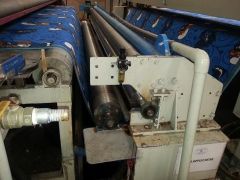 L-4753 COMPLETE ZIMMER CHROMOJET LINE, WIDTH 4000mm, YEAR 2000
L-4753 COMPLETE ZIMMER CHROMOJET LINE, WIDTH 4000mm, YEAR 2000COMPLETE ZIMMER CHROMOJET LINE, WIDTH 4000mm, YEAR 2000
WIDTH: 4000mm
YEAR: 2000
DPI: 1.666mm = 16 DOTS PER INCH (DPI)
2560 JETS
EACH PUMP WITH 256 JETS (10 PUMPS TOTAL)
JETS ARE IN GOOD CONDITION, TO PRINT ALL KINDS OF CARPETS OF ANY WEIGHT OR PILE HEIGHT
CAN PRINT DOT OR HALF DOT
10 COLORS
COULD BE USED ALSO FOR BLANKETS
Learn More -
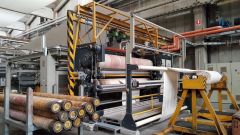 S-1220 KUSTERS CALANDER AND EMBOSSING CALENDER, WORKING WIDTH 3400mm, YEAR 2002
S-1220 KUSTERS CALANDER AND EMBOSSING CALENDER, WORKING WIDTH 3400mm, YEAR 2002S-1220 KUSTERS CALANDER AND EMBOSSING CALENDER, WORKING WIDTH 3400mm, YEAR 2002
KUSTERS CALANDER AND EMBOSSING CALENDER
MAKE: KUSTERS
YEAR: 2002
TYPE: 213.40/3400
WORKING WIDTH: 3400mm
3 CYLINDERS
COTTON – STEEL – RACOLAN
HYDRAULIC PRESSURE MAXIMUM 40 TONES
COMPLET ENTRY WITH METAL DETECTOR AND SEWING DETECTOR
5 DIFFERENT STEEL EMBOSSING CYLINDERS
PREPARED FOR OIL HEATING WITH PUMP AND VALVES
EXIT WITH SALVADE AXIAL A-FRAME ROLLING DEVICE
INCLUDING TWO MANUAL HAND CRANES
WITH FRAME TO CHANGE THE CYLINDERSMACHINES ARE STILL RUNNING
QUANTITY: 1
Learn More -
 C-4076 COMPLETE BLANKET MANUFACTURING PLANT, YEAR 1994 TO 2002
C-4076 COMPLETE BLANKET MANUFACTURING PLANT, YEAR 1994 TO 2002REFERENCE NUMBER: C-4076
COMPLETE BLANKET MANUFACTURING PLANT, YEAR 1994 TO 2002
DYEING
OFFER 001PRESS AIPA-CIMA
TYPE: PM / 2 (7 KW)
YEAR: 1994
QUANTITY: 1OFFER 002
AUTOCLAVE AIPA
MODEL: HT 200 / D
YEAR: 1994
CAPACITY: 5700 LIT
4.5 BAR
QUANTITY: 1OFFER 003
CENTRIFUGE CIMA IMPIANTI
YEAR: 1994
185 KW
QUANTITY: 1OFFER 004
CRANE OMIS
WITH WINCH AND BASKET
YEAR: 1994
QUANTITY: 1
OFFER 005DRYER SN. LUCIA LTD
2 DRUMS
HEIGHT: 1600mm
YEAR: 1994
QUANTITY: 1
OFFER 006PRESS
TRANSPORT EQUIPMENT FOR WET FIBERS
FORKLIFTS
COMPRESSORS
ETC.
SPINNING
OFFER 007
FIBER MIXING PLANTMODEL: 3652 AND 3660
MANUFACTURER: MECHANICAL CARESI LTD. AND T. BRACCIOLINI
YEAR: 1994
QUANTITY: 2OFFER 008
BONINO CARDING MACHINE
MODEL: CA 83
YEAR: 1994
DELIVERY IN CANS
QUANTITY: 1OFFER 009
RIETER DRAWING MACHINE SB2
YEAR: 1994
QUANTITY: 1
OFFER 010RIETER OPEN END
MODEL: RL10
YEAR: 1994
QUANTITY: 1
OFFER 011100 BARRELS FIBERS
COMPRESSOR
PALETTE FOR YARNS
TROLLEYS
ETC.
WEAVINGOFFER 012
HACOBA WARPERMODEL: US-B
YEAR: 1994
WIDTH: 3000mm
SPEED: 20 TO 600 M/MIN
WITH CREEL 490 COILSQUANTITY: 1
OFFER 013
SOMET THEMA SUPER-EXCEL
WIDTH: 3000mm
YEAR: 2001
WITH JACQUARD GROSSE
MODEL: EJP2
QUANTITY: 1
OFFER 014
SOMET THEMA EXCEL
WIDTH: 2200mm
YEAR: 2002
JACQUARD GROSSMODEL: EJP 2
QUANTITY: 2OFFER 015
SOMET THEMA 11E
WIDTH: 2200mm
YEAR: 1994
GROSSE JACQUARDMODEL: EJP
QUANTITY: 9OFFER 016
WITH 24 BEAMS
VARIOUS TROLLEYS
ETC.
FINISHINGOFFER 017
MARIO CROSTA SRL WOOLLY 2MODEL: MC 10/30
YEAR: 1994
QUANTITY: 1OFFER 018
WOOLLY MULLER GMBH
TRI 224
PR- 1
YEAR: 1994
WIDTH: 2200mm
QUANTITY: 2OFFER 019
MULLER MOWERS
YEAR: 1994
QUANTITY: 3OFFER 020
REAM OF STEAMING (SCREED) TO SANTA LUCIA
BRAND: FABRICS
YEAR: 1994
QUANTITY: 1
OFFER 021COMPRESSOR
BOILER FOR STEAM VAPORAX 1000
ETC.
MAKINGOFFER 022
HEMING LINE FROM MAGETRON S, R, LYEAR: 1995
QUANTITY: 1OFFER 023
SEWING MACHINES
OF DIFFERENT TYPES AND MODELS
ETC.
OFFER 024
BOILERWATER TREATMENT
OTHER PERIPHERICAL EQUIPEMENT
QUANTITY: 1 PLANT
Learn More -
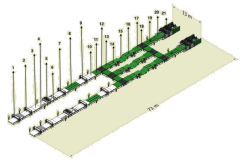 K-5014 HOTMELT GLUING MATTRESS PRODUCTION LINE 2200mm 1000 MATTRESSES PER 8-HOUR SHIFTREFERENCE NUMBER: K-5014 HOTMELT GLUING MATTRESS PRODUCTION LINE 2200mm 1000 MATTRESSES PER 8-HOUR SHIFT MAXIMUM WIDTH: 2200mm CAPACITY: 1,000 MATTRESSES PER 8-HOUR SHIFT 1ST BRIDGE: 3 PNEUMATICALLY MOVING GUNS WITH 4 NOZZLES ON EACH HOTMELT GUN. CAN BE CONVERTED TO SPRAY AT NO EXTRA COST. 2ND BRIDGE: 2 GUNS FOR THE EDGE: ONE HAS 8 NOZZLES (T-SHAPED), THE OTHER HAS 4 NOZZLES. 3RD BRIDGE: 3 PNEUMATICALLY MOVING GUNS. THEY ARE SPRAY; LINE NOZZLES CAN BE ADDED 4TH BRIDGE: EXACTLY THE SAME AS 3RD BRIDGE. FLOORSPACE DIMENSIONS: 72000mm X 13000mm QUANTITY AVAILABLE: 1 Learn More
K-5014 HOTMELT GLUING MATTRESS PRODUCTION LINE 2200mm 1000 MATTRESSES PER 8-HOUR SHIFTREFERENCE NUMBER: K-5014 HOTMELT GLUING MATTRESS PRODUCTION LINE 2200mm 1000 MATTRESSES PER 8-HOUR SHIFT MAXIMUM WIDTH: 2200mm CAPACITY: 1,000 MATTRESSES PER 8-HOUR SHIFT 1ST BRIDGE: 3 PNEUMATICALLY MOVING GUNS WITH 4 NOZZLES ON EACH HOTMELT GUN. CAN BE CONVERTED TO SPRAY AT NO EXTRA COST. 2ND BRIDGE: 2 GUNS FOR THE EDGE: ONE HAS 8 NOZZLES (T-SHAPED), THE OTHER HAS 4 NOZZLES. 3RD BRIDGE: 3 PNEUMATICALLY MOVING GUNS. THEY ARE SPRAY; LINE NOZZLES CAN BE ADDED 4TH BRIDGE: EXACTLY THE SAME AS 3RD BRIDGE. FLOORSPACE DIMENSIONS: 72000mm X 13000mm QUANTITY AVAILABLE: 1 Learn More -
 M-4426 KUSTERS CALENDER YEAR 2008 WIDTH 3200mREFERENCE NUMBER: M-4426 (10102MNJHX9RX) K KUSTERS CALENDER YEAR 2008 WIDTH 3200mm KUSTERS CALENDER YEAR 2008 WORKING WIDTH 3200mm PLC CONTROLLED CONTROL PANEL A HYDRAULIC MOTOR DRIVEN ROLLERS POLYAMIDE AUTOMATIC ROLL COOLING SYSTEM METAL DETECTOR AUTOMATIC SEWING CONTROL SYSTEM EDGE HOLDING SYSTEM STATIC ELECTRICITY RECEIVER CLOSED CIRCUIT OIL HEATING SYSTEM ROLLER BEARING SYSTEM ALL CAMERA CONTROLS CAN BE PERFORMED ON DIGITAL SCREEN ALL MALFUNCTIONS THAT MAY OCCUR, CAN BE SEEN ON THE DIGITAL DISPLAY CHROME CYLINDERS INDISE AND OUTSIDE SURFACE TEMPERATURE CAN BE MEASURED AT VARIOUS POINTS POLYAMIDE ROLLERS TEFLON BASED COMPUTER-AIDED SPECIAL GRINDING MACHINES ARE GRIND. 2 ROLLS (CYLINDERS) QUANTITY AVAILABLE: 1 Learn More
M-4426 KUSTERS CALENDER YEAR 2008 WIDTH 3200mREFERENCE NUMBER: M-4426 (10102MNJHX9RX) K KUSTERS CALENDER YEAR 2008 WIDTH 3200mm KUSTERS CALENDER YEAR 2008 WORKING WIDTH 3200mm PLC CONTROLLED CONTROL PANEL A HYDRAULIC MOTOR DRIVEN ROLLERS POLYAMIDE AUTOMATIC ROLL COOLING SYSTEM METAL DETECTOR AUTOMATIC SEWING CONTROL SYSTEM EDGE HOLDING SYSTEM STATIC ELECTRICITY RECEIVER CLOSED CIRCUIT OIL HEATING SYSTEM ROLLER BEARING SYSTEM ALL CAMERA CONTROLS CAN BE PERFORMED ON DIGITAL SCREEN ALL MALFUNCTIONS THAT MAY OCCUR, CAN BE SEEN ON THE DIGITAL DISPLAY CHROME CYLINDERS INDISE AND OUTSIDE SURFACE TEMPERATURE CAN BE MEASURED AT VARIOUS POINTS POLYAMIDE ROLLERS TEFLON BASED COMPUTER-AIDED SPECIAL GRINDING MACHINES ARE GRIND. 2 ROLLS (CYLINDERS) QUANTITY AVAILABLE: 1 Learn More
